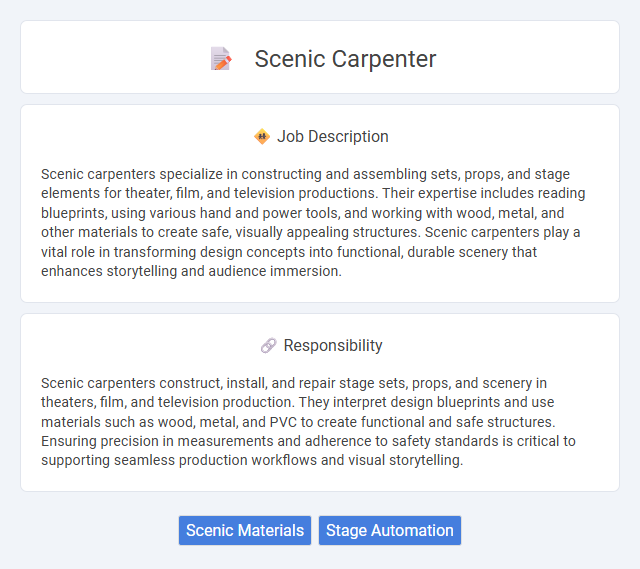
Scenic carpenters specialize in constructing and assembling sets, props, and stage elements for theater, film, and television productions. Their expertise includes reading blueprints, using various hand and power tools, and working with wood, metal, and other materials to create safe, visually appealing structures. Scenic carpenters play a vital role in transforming design concepts into functional, durable scenery that enhances storytelling and audience immersion.
Individuals with strong spatial awareness and manual dexterity are likely to find scenic carpenter roles well-suited to their skills. Those who enjoy hands-on work in physically demanding environments may thrive, whereas people who prefer sedentary or less physically intensive jobs might not adapt as easily. It is probable that candidates with creative problem-solving abilities and a keen eye for detail will excel in this dynamic, craft-focused profession.
Qualification
Scenic carpenters require proficiency in woodworking, blueprint reading, and stagecraft techniques to construct and install theatrical sets efficiently. Mastery in hand tools, power tools, and materials like plywood, foam, and metal is essential for creating durable and visually accurate scenic elements. Certifications in safety protocols and prior experience in theatre or film production greatly enhance job qualifications.
Responsibility
Scenic carpenters construct, install, and repair stage sets, props, and scenery in theaters, film, and television production. They interpret design blueprints and use materials such as wood, metal, and PVC to create functional and safe structures. Ensuring precision in measurements and adherence to safety standards is critical to supporting seamless production workflows and visual storytelling.
Benefit
Scenic carpenters likely experience benefits such as developing specialized skills in set construction, which can enhance job security in the entertainment industry. They may also have opportunities for creative expression and collaboration with designers, potentially leading to career advancement. Access to diverse projects could increase job satisfaction and provide valuable networking connections.
Challenge
Scenic carpenter roles likely involve complex problem-solving to construct durable, visually precise sets under tight deadlines. The challenge may stem from balancing artistic vision with structural safety, requiring advanced woodworking and rigging skills. Navigating changes in design blueprints quickly could also be a frequent and demanding aspect of the job.
Career Advancement
Scenic carpenters specialize in constructing and assembling sets for theater, film, and television, using advanced woodworking and design skills. Mastery of technical tools and a deep understanding of scenic design principles can lead to roles such as lead carpenter, shop foreman, or production manager. Networking within creative industries and continuous skill development accelerate career advancement and open opportunities for higher-profile projects.
Key Terms
Scenic Materials
Scenic carpenters specialize in constructing and assembling detailed scenic materials for theater, film, and television productions, including wood, foam, and lightweight metals. They expertly shape and finish these materials to create realistic set pieces, backdrops, and props that enhance the visual storytelling. Mastery of various scenic materials and techniques ensures durability and safety while achieving the desired aesthetic impact.
Stage Automation
Scenic carpenters specializing in stage automation design, build, and maintain intricate moving set pieces that enhance theatrical productions. Their expertise includes operating automated rigging systems, hydraulic lifts, and motorized platforms to ensure seamless scene transitions. Proficiency in mechanical systems and safety protocols is essential for executing dynamic stage effects with precision and reliability.
 kuljobs.com
kuljobs.com